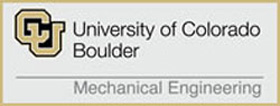Syllabus for Spring 2021
Syllabus_ Raj_Spring 2021Mech Mat Sci_5228/4228
Overview, and topics
This course has the following unique features,
•It is an interdisciplinary and basic science course. It draws from the following areas, materials science, mechanical engineering, mechanics, thermodynamics and chemical physics.
•It emphasizes quantitative learning, pulling together concepts and science from these different fields into phenomena that bridge length scales: from the atomic, to the laboratory length scale, to physical devices. Models are derived that link fundamental properties of materials at these successive length scales into analytical expressions for guiding and interpreting laboratory data.
•The course is divided into four distinct sections: elastic properties, plasticity, fracture and high temperature phenomena. Each topic is separated by its own exam, with each contributing approximately equally to the final grade. Each of these are described in more detail below.
The course will be useful to students, researchers and practitioners.
Description of TopicsElastic Behavior
Elastic properties are interesting because laboratory measurements can be unambiguously related to the bonding and stretching of bonds among nearest neighbors in the solid state. This section includes the following topics
•Elastic constants, energy of elastic deformation and enthalpy of bonds between atoms. Maps that link one property to another, for example density to the Youngs Modulus are described. These maps help to distinguish between different classes of materials for example, metals, ceramics, and polymers.
•Distinction between, and the significance of, different types of deformation states for example, in uniaxial tension, shear and hydrostatic pressure.
•Fundamental mechanical properties for example elastic constants are related to the Periodic Table and the Electronegativity of elements.
•Simple boundary values problems are described for example the stress and strain field around a spherical inclusion in a matrix.
Plastic DeformationMetals and polymers can be deformed into different shapes but ceramics are prone to fracture. These distinctions are related to the fundamental mechanisms of plastic deformation and fracture (the latter topic is dealt with separately in much more detail).
•Formulation of problems with large strains, as in plastic deformation, as opposed to small deformations as experienced in elastic deformation.
•Explanation of plastic deformation at the atomic length scale, and its consequences in the behavior of different metals, different crystal structures, and large strain deformation in metals. Why some metals are prone to fracture while others are ductile, is addressed?
•Sheet metal forming is formally described in forming limit diagrams which show the influence of different ways of deformation modes (stretching in one direction versus biaxially) on the formability of sheet metal.
•Mechanisms for increasing the resistance to plastic deformation by processing to produce nanoscale dispersion of hard particles in a metal matrix.
FractureThe fundamentals of fracture phenomenon are studied from a thermodynamic standpoint that is the work of fracture is related to the work done upon a system.
We shall address the phenomenon of fracture in brittle and semi-brittle materials such as glass, ceramics and hard metals (e.g. tool steels).
•The macroscopic theory of fracture is developed with principles of thermodynamics where the system exchanges energy with the surroundings.
•Just as the Youngs Modulus describes elastic deformation, the resistance to fracture is described in terms of fracture toughness. Fracture toughness becomes a material parameter which can be used to relate laboratory experiments to engineering failure (for example in the wings of an aircraft).
•The understanding of fracture at the atomic length scale is studied in terms of the forces and displacements at the tip of an advancing crack. These analyses clarify the distinction between high brittle fracture as in glass and fracture in tool-steels which display considerable resistance to fracture. However, both situations can be tackled with the same fundamental approach that links the thermodynamic description of fracture to the progression of the crack tip by atomistic mechanisms.
•A third category of fracture known as slow-crack-growth or stress-corrosion cracking will be described. The time dependent propagation of cracks of glass in different liquid environments is related to the size of the molecules of the liquid.
High Temperature PhenomenaMechanical properties of ceramics, glasses and polymers at high temperature are time-dependent, that is, deformation accrues with time. Such time dependent deformation is related to the movement of atoms at the nanoscale, also known as solid state diffusion.
•The movement of atoms is related to coefficients of diffusion for mass transport. The flux of atoms via diffusion is described in terms of the chemical driving force.
•Principles of chemical physics and mechanics are invoked to describe the chemical driving force in terms of mechanical forces.
•The flux equations and the chemical driving forces derived just above are combined with length scales related to the microstructure, e.g. the grain size, to develop models for time dependent deformation and fracture in solids.
•The implications of the above models in failure prediction of high temperature systems, for example turbine blades in jets and nuclear reactors are discussed.
Text BookIt is difficult to specify one book because the field is very interdisciplinary. Every author (including me) thinks differently with a different emotional relationship to the subject. I would recommend that you buy the following book, which has been around for a long time and my still be available at Amazon. It conveys at least some of the concepts covered in this course in a simple way. It also develops simple models, akin to the spirit of the course.
The following book is available on amazon.com/books, in hard cover and paperback versions. •The Mechanical Properties of Matter: Alan H. Cottrell, 1964, Wiley
Another book is by George Dieter is related to engineering aspects of mechanical properties •Mechanical Metallurgy, 3rd Edition
I will supplement the lectures with handouts, and written notes.